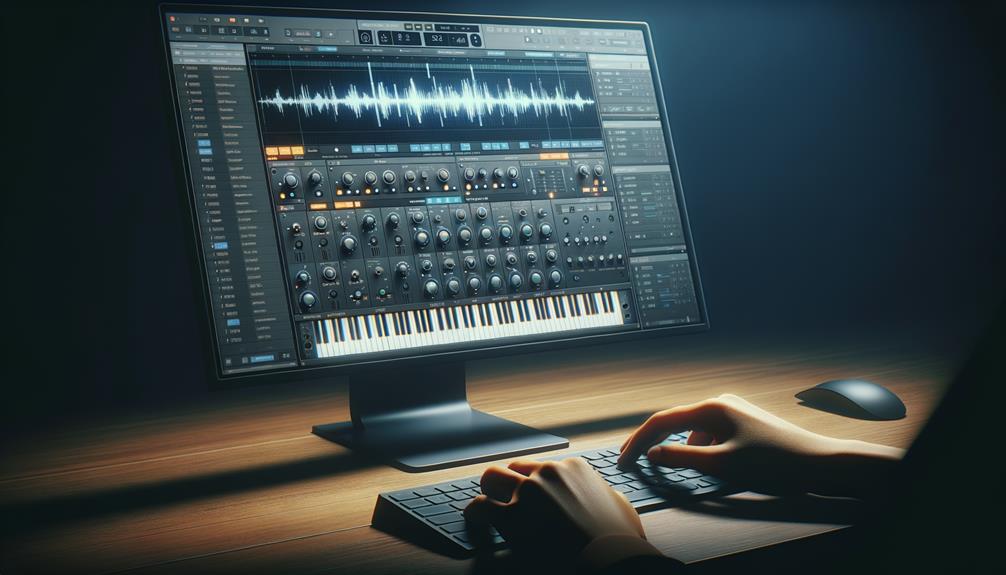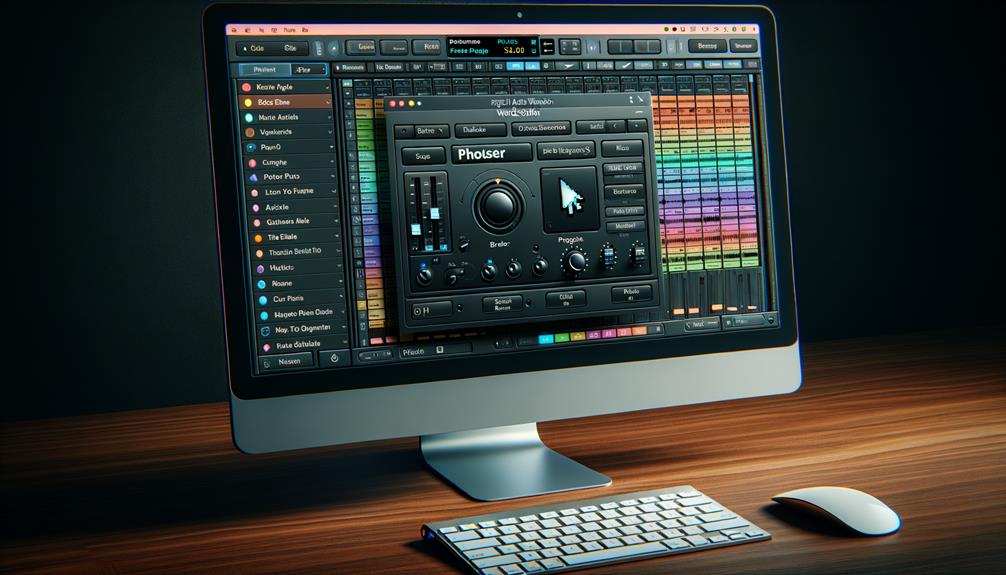No products in the cart.
To master Kontakt in Ableton, begin by installing Kontakt via Native Access, ensuring it recognizes your custom VST folder paths. Load instruments by opening Kontakt on a MIDI track, and delve into tweaking parameters to suit your sound — explore the library for diverse instruments. Map MIDI controls for dynamic interaction; simply right-click parameters in Kontakt to assign MIDI CC automation. Utilize Kontakt’s library using the sorting and filtering features to efficiently find sounds. Apply effects and comprehend modulation routing for sonic layering. Utilize scripting for nuanced control and set up multi-output routing for complex mixes. Keep exploring these steps to deepen your mastery further.
Key Takeaways
- Set up and customize VST paths in Native Access for Kontakt integration with Ableton.
- Explore and load Kontakt instruments, adjusting parameters to fit your production needs.
- Map MIDI controls in Kontakt to enhance sound sculpting and real-time adjustments.
- Utilize Kontakt’s Effects Rack and modulation options to create dynamic textures in your tracks.
- Set up multi-output routing in Kontakt to manage complex mixes and enhance workflow in Ableton.
Installing Kontakt in Ableton
To install Kontakt in Ableton, first set up Native Access preferences and specify your custom VST folder paths. Begin by launching Native Access, the software gateway for managing your Native Instruments products. Within Native Access, navigate to the ‘Preferences’ section. Here, you’ll focus on setting preferences specifically for VST plugin locations. This is important because Ableton needs to know where to find the Kontakt VST files to function properly.
Choose or create a folder on your hard drive where you’ll store all your VST plugins. It’s best to keep all VST files in one place to avoid confusion and streamline your workflow. After selecting your custom VST folder in Native Access, remember this path.
Next, open Ableton and head to its preferences. In the ‘Plug-ins’ tab, you’ll find an option to add new VST plug-in custom folders. Here, input the exact path to your designated VST folder that you set in Native Access. This links Ableton with Kontakt by acknowledging where the VST files reside, ensuring that Kontakt will be accessible when you’re ready to add it to your music projects.
Loading Kontakt Instruments
Once you’ve opened Kontakt on a MIDI track in Ableton, you can start loading instruments by selecting them from Kontakt’s browser. This is where you’ll find a vast library of sounds, ranging from classical orchestration to cutting-edge electronic beats. Here’s how to navigate this process effectively:
- Explore the Library: Begin by exploring presets available in Kontakt’s vast library. This initial exploration is important as it gives you an insight into the diverse sonic possibilities. Skim through categories and subcategories to find sounds that best suit your musical vision.
- Load and Preview: Once you’ve spotted a potential instrument, double-click to load it. You can then preview the sound by playing a few notes or using the built-in keyboard in Kontakt. This step is crucial for evaluating the sonic characteristics of the instrument.
- Adjust Parameters: After loading an instrument, delve into tweaking its parameters. Utilize sound design techniques to shape the sound to your preference. Manipulate filters, envelopes, and effects within Kontakt’s interface to enhance or completely transform the instrument’s natural sound.
Mapping MIDI Controls
Mapping MIDI controls to Kontakt parameters significantly enhances your ability to sculpt and modify sounds in real-time within Ableton. Start by right-clicking on the parameter you want to manipulate in Kontakt and select ‘Learn MIDI CC Automation.’ This action allows you to assign any knob, slider, or pad on your MIDI controller to control that specific parameter. It’s important in your MIDI controller setup to make sure that each control is mapped thoughtfully to streamline your workflow and enhance your performance dynamics.
Once mapped, these controls can be used for real-time manipulation of sounds, giving you the power to tweak and adjust your audio as you perform or record. This flexibility is key for creating dynamic performances and for employing creative automation that keeps your audience engaged. By customizing MIDI mappings specific to different instruments or effects in Kontakt, you tailor your setup to match your musical needs and preferences, making your setup as unique as your sounds.
Exploring Kontakt’s Library

As you explore Kontakt’s library in Ableton, you’ll first need to navigate through the instrument database effectively.
By utilizing the sound collections, you can access a rich tapestry of sounds that cater to a variety of musical genres and production needs.
You can effortlessly explore Kontakt’s extensive library through its well-organized browser interface, which categorizes instruments by type, genre, and characteristics to streamline your music production process. This setup is essential for efficient sound selection and instrument organization, ensuring you find the perfect sounds swiftly:
- Type Filtering: Select from categories like strings, percussion, or synths, focusing your search on the instrument type most suited to your track.
- Genre Sorting: Whether you’re producing cinematic scores or electronic music, genre-specific sorting helps you delve into the appropriate sound pool.
- Characteristics Browsing: Attributes like bright, dark, or ambient further refine your search, tailoring the library to your creative vision.
Utilizing Sound Collections
Explore Kontakt’s library to uncover a diverse range of sound collections that cater to every musical genre, from orchestral to electronic, enriching your production with each selection. Utilizing Kontakt’s powerful search and tagging system, you’ll navigate effortlessly, finding the perfect sounds swiftly. Immerse yourself in sound design by layering and customizing sound samples to craft unique sonic landscapes, employing creative techniques that push the boundaries of music production.
| Category | Description |
| Orchestral | Rich, expansive symphonic textures |
| Electronic | Cutting-edge synths and beats |
| World | Authentic ethnic instruments |
| Cinematic | Dramatic, scene-setting sounds |
Stay updated with expansions and new releases to continuously refine your sound palette in Ableton.
Customizing Instrument Settings
Explore customizing instrument settings in Kontakt’s library to fine-tune pianos, strings, drums, and synths, enhancing their musical expression and adaptability in your tracks. Investigate Kontakt’s interface to manipulate parameters that elevate your sound design techniques and boost performance optimization.
Here’s how you can achieve that:
- Adjust Envelope and Filters: Shape the dynamics and tone of your instruments by tweaking the attack, decay, sustain, and release alongside cutoff and resonance settings.
- Utilize Articulations and Performance Controls: Harness key switches and velocity layers to bring realism and expressive depth to your performances.
- Scripting and Modulation: Explore advanced scripting for creative soundscaping and leverage LFOs and step sequencers for rhythmic innovations, enhancing workflow efficiency.
Save your settings as presets for quick recall in future projects.
Applying Effects and Modulation

You’ll need to master Kontakt’s Effects Rack and understand the modulation routing techniques to fully exploit its potential in Ableton Live.
Start by integrating Kontakt’s extensive effects, such as reverbs and delays, into your workflow and map these parameters to Ableton’s macros for streamlined control and automation.
Then, employ Kontakt’s modulation options, like LFOs and envelopes, to dynamically shape your sound, ensuring your musical expressions are both unique and impactful.
Exploring Kontakt’s Effects Rack
Explore Kontakt’s Effects Rack where you can apply and manipulate a diverse array of effects, from reverb and delay to distortion and modulation, to enhance and shape your sounds with precision. This tool is pivotal for sound manipulation and creative processing, enabling you to craft unique audio landscapes.
Here are key functionalities you’ll find useful:
- Dynamic Effect Chains: Build complex chains of effects to achieve intricate sound designs. Experiment with combining reverb with a touch of phaser or layer multiple distortions for richer textures.
- Automation Capabilities: Automate parameters within the effects for evolving soundscapes that respond to your track’s dynamics.
- Experimentation Platform: Use the rack as a sandbox for testing new effect combinations and pushing the boundaries of conventional audio processing.
Modulation Routing Techniques
Exploring the Effects Rack, let’s now focus on how you can dynamically apply effects and modulate your sounds using Kontakt’s advanced modulation routing techniques.
Immerse yourself in the modulation matrix where you’ll assign sources like LFOs, envelopes, and step sequencers to various targets for intricate sound manipulation.
This setup allows you to create evolving textures and dynamic effects that bring life to your tracks. Experiment with combining multiple modulation sources and built-in effects to add depth and movement.
Advanced Scripting Techniques
Delving into advanced scripting techniques in Kontakt, you can customize instrument behaviors and enhance interactions with external controllers to elevate your music production in Ableton. Mastering Kontakt’s scripting through its Kontakt Script Processor (KSP) allows you to exploit the full power of this tool within your Ableton projects.
Here are some key scripting capabilities you should explore:
- Advanced Automation Techniques: Script dynamic parameter control to react to user inputs or external signals. This can vastly improve the nuance and detail in your soundscapes.
- Real-Time Performance Enhancements: Enhance the expressiveness of your instruments with real-time script processing. This includes creating complex MIDI mappings that respond to performance nuances.
- MIDI Expression Mapping: Tailor how MIDI controllers interact with Kontakt instruments, assigning multiple parameters to a single MIDI controller for more intuitive performance control.
Multi-Output Routing Setup
Why not take your music production to the next level by setting up multi-output routing in Kontakt for enhanced control and separation of sounds in Ableton Live? To begin, create separate audio output channels in Kontakt. This setup allows you to assign each instrument or effect to a designated output channel, facilitating individual processing in Ableton.
In Kontakt, navigate to the output section and configure the number of outputs you need. For each output, you can rename and save the configuration to streamline your workflow. Next, assign each of your loaded instruments or effects to these outputs. This is achieved by selecting the instrument and choosing the appropriate output channel from the dropdown menu in the instrument’s output routing settings.
Once you’ve configured Kontakt, open Ableton Live and set it up to recognize these multiple audio output channels. In Ableton, create new audio tracks corresponding to each output channel from Kontakt. Route the audio from each Kontakt output to the respective Ableton track using Ableton’s external audio effect device. This setup enables you to apply customized effects and processing chains to each sound individually, optimizing your mix and enhancing your music production quality.
Frequently Asked Questions
How Do I Use Kontakt Player in Ableton?
To use Kontakt Player in Ableton, load it as a VST on a MIDI track, route its audio output, and customize settings. Employ MIDI mapping and instrument routing for tailored sound control.
How Do I Automate Kontakt Parameters in Ableton?
To automate Kontakt parameters in Ableton, use parameter mapping to assign controls. Then, create automation envelopes in Ableton’s timeline to dynamically adjust these settings during playback for precise sound manipulation.
How Do I Make Kontakt Run Faster?
To make Kontakt run faster, reduce polyphony and voices, use disk streaming, optimize buffer size and sample rate, disable unnecessary effects, and keep everything updated. This’ll optimize performance and reduce latency in your setup.
How Do I Use Kontakt Standalone?
To use Kontakt standalone, open the application, grant permissions, and select your audio and MIDI devices. Navigate the interface to load sound libraries and explore settings for efficient standalone music production.
Conclusion
Now that you’ve fully immersed yourself in Kontakt in Ableton, you’re all set to enhance your music production. Remember to keep exploring with different instruments and effects within Kontakt’s extensive library.
Don’t hesitate to delve into MIDI mapping and advanced scripting to customize sounds precisely to your requirements. Setting up multi-output routing will further streamline your workflow.
Keep pushing the boundaries of what you can create, and let your unique sounds captivate your audience.




